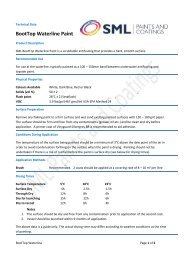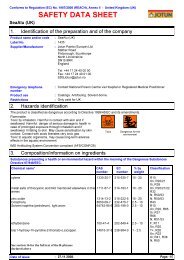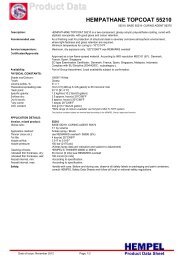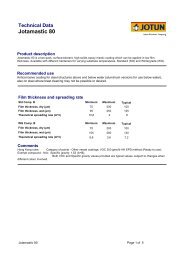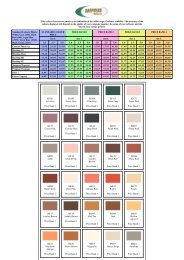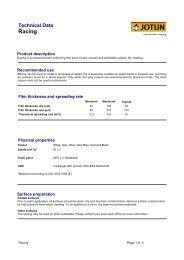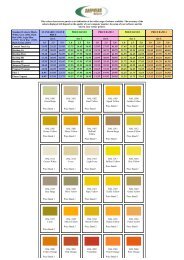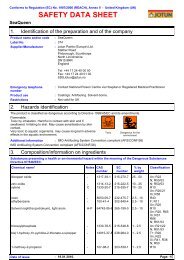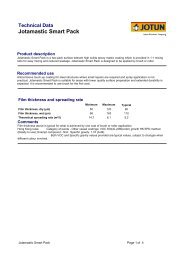tech info for website2.pub - SML Marine Paints
tech info for website2.pub - SML Marine Paints
tech info for website2.pub - SML Marine Paints
Create successful ePaper yourself
Turn your PDF publications into a flip-book with our unique Google optimized e-Paper software.
Technical In<strong>for</strong>mationChoosing Your Antifouling<strong>Marine</strong> fouling growth willaffect all vessels, althoughthe type and density will bedependent on many factorsincluding how often the vesselis used, where the vesselis kept and what type of antifoulingyou apply.Fresh water doesn’t usuallyincur many fouling problems,mainly just light weedand slime, however sea andrivers are abundant with marinelife and a vessel can foulup very quickly.A good and well chosen antifoulingwill protect yourvessel and stay relativelyclean throughout a season,on the other hand a poorantifouling willnot stay cleanand as it fouls upwill slow downyour vessel andmaximum speedwill not be ableto be achieved.Aluminium vesselsmust not use any standardantifouling which containscopper as this willcause bi-metallic corrosionand could lead to seriousdamage to your vessel.SeaAlu tin and copper freeantifouling should be usedon Aluminium Hulls.Most vessels will apply freshantifouling every spring inorder to ensure peak per<strong>for</strong>manceduring the Springand Summer months.At the end of the seasonscrub the hull clean and washdown with fresh water, theremay be some antifoulingremaining but this is unlikelyto be sufficient <strong>for</strong> anotherseason.Special points of interest:Preparation and PaintingKeys PointersTroubleshooting GuideWhat Paint System To UseInside this attachmentChoosing your antifouling 1Preparation and Painting 1Other Products Required 2Key Pointers 3Troubleshooting Guide 4Preparation and PaintingWhat Paint System to Use? 6Frequently Asked Questions 7Safe ApplicationAll paints contain chemicalsand care should always betaken when handling them.All paints should be used inwell ventilated conditionsand if ventilation is inadequatea respirator must beworn. Please use the relevantSafety and Technical Datasheets <strong>for</strong> your productsavailable fromwww.jotun.comEquiptment NeededIn addition to the applicationequiptment you will alsoneed waterproof sandingpaper, masking tape andclean cotton rags. Rollers canbe used <strong>for</strong> priming and antifoulingbut not <strong>for</strong> the initialcoat of primer, which shouldbe applied by brush. Whenapplying primers a wet filmthickness gauge is useful tocheck <strong>for</strong> correct film thickness.Surface PreparationGood surface preparation isessential . Previously paintedsurfaces must be thoroughlydegreased using a watersoluble degreaser whichmust be washed off afterwardswith clean fresh water.After degreasing the surfacemust be sanded down andwashed again to removesanding debris and allowedto dry. If the existing paint isin a poor condition it shouldbe taken back to sound paintor removed altogether.
Preparation and Painting contd.Page 2Preparing the Paint<strong>Paints</strong> and antifoulings should be stirredthoroughly be<strong>for</strong>e use to re-incorporateany pigment which has settled. For twopack products stir the individual componentsbe<strong>for</strong>e mixing the two togetherand also use the recommended ratio.Adding extra curing agent will not makethe paint dry any faster. Failure to mixtwo pack products thoroughly will resultin insufficient curing agent in some ofthe paint, resulting in weaknesses in thepaint film after curing.ApplicationNever use cold paints or varnishes asthey will be difficult to apply, if necessarystand them in a bucket of warmwater . Do not add solvent to try to compensate<strong>for</strong> cold conditions. You mustalso ensure that the surface you arepainting is not too cold, some two packpaints will not cure on cold surfaces andthere is also the risk of condensation.When working in warm conditions,work relatively quickly to avoid brushmarks.Always finish outdoor paintwork byearly afternoon to avoid possible overnightdew.Other Products RequiredPrimersPrimers are specific to certain substratesand will provide maximum adhesion to,and protection of, the material concerned.For example Aluminium andGRP vessels must use Penguard HB as aprimer, whereas Steel vessels should useJotamastic. Primers are designed to beanticorrosive and provide a moisturebarrier. A dry film thickness (dft) ofapproximately 250 to 300 microns isusually specified.Sealer / Tie CoatsA tie coat <strong>for</strong> example Vinyguard Silvergreywill be required between the primer and antifouling.Vinyguard Silvergrey can also beused to seal off any existing antifouling ifyou are not sure what is already on your vesseland there<strong>for</strong>e not sure of its compatibility.ThinnersSolvents are used to adjust viscosity and <strong>for</strong>cleaning afterwards. Always use the appropriatethinners when you buy the paint.Non-Skid AdditiveThese are fine particles which can beadded to any topcoat to prevent anyone slipping on the surface. Apply onecoat of topcoat as you normally wouldand then scatter the non-skid particlesover the surface, when dry then apply avery thin second coat of topcoat. Werecommend 1.5 - 2kg of non skid toevery 10 litres of paint.Changing from one Antifouling to anotherWith just a few exceptions, mostcurrent vessel antifoulings can beovercoated with Jotun equivalents,but if in doubt please contact Jotunor your local distributor.“ What does ‘film thickness’ mean?Film thickness is a measure of thedepth of an individual coat of paint,measured in microns. There are 1000microns in a millimetre.” Dry filmthickness and wet film thickness canboth be measured.
Key Pointers to Ensure Good Paint Per<strong>for</strong>mancePage 31 All equiptment should be cleanand checked to ensure it is inperfect working order and is theright equiptment <strong>for</strong> the job.2 The correct type of paint must beused and it is important to carefullyfollow the specification <strong>for</strong>the actual area to be painted.3 Read the instructions on theTechnical and Safety Data Sheetsavailable from www.jotun.comobserve the safety precautionsand do not smoke whilst painting.4 Avoid inhaling solvent vapours.Ensure there is good ventilationif working in an enclosed area.5 It is always advisable to weargoggles, mask and gloves. Alwayswash your hands with ahand cleaner or soap and water.Do not use thinners or solvents toclean your hands.6 Be<strong>for</strong>e painting commences preparea plan of how the tins ofpaint are to be distributed overthe surface. Separate the area tobe painted into reasonable sectionsand distribute the paint tinsaccordingly. This method helpsto achieve a more even distributionof paint over the entire surfaceand ensures the quantity ofpaint corresponds to the specification.7 Paint must be thoroughly mixedotherwise the quality may not beas expected. This is essential asthe heaviest pigment in the paintsinks to the bottom of the tin.8 Adhere carefully to instructionsregarding the potlife (that’s howlong be<strong>for</strong>e it becomes unusable).Potlife decreases as temperatureincreases and vice versa.9 Avoid unnecessary thinning. Incold weather it is advisable tokeep the paint at room temperature.10 Measurement of temperaturesmust be carried out in the vicinityof where application takes place.11 When painting, the temperatureof the substrate should be a minimumof 3°C above the dew-pointto avoid condensation.12 Follow the instructions regardingthe recommended spreading rate<strong>for</strong> the paint.13 Check the drying times, whatmay appear to be dry may not be.The ideal temperature range <strong>for</strong>applying paint is between 15—25°C with humidity at 85%maximum. Outside these rangesthe drying times will be affected.14 Paint should never be applied to awet surface or during rain. Avoidpainting when it is windy andavoid direct sunlight. Don’t paintlate in the day, remember eveningsand night time are whenmoisture <strong>for</strong>ms.15 Sacrificial anodes must be replaced.It is essential that newanodes are not painted and it isadvisable to protect them withaluminium foil. Tape may alsobe used. Remember to removethe foil or tape after painting.Additional cleaning may be required.16 The wet film thickness must bemeasured at frequent intervals.The recommended thicknessmust be maintained throughoutthe painting.17 Pay special attention to areaswhich were covered by keelblocks at the last painting.18 The drying time between eachcoat must be in accordance withthe current Technical Data Sheet<strong>for</strong> the product.19 On Technical Data Sheets a typicaldry and wet film thickness isshown. This is normally onlyachieved by airless spray application.To obtain the recommendeddry or wet film thickness bybrush or roller, the number ofcoats needed may at least need tobe doubled.
Jotun ProductsPage 4AntifoulingsSeaForce 30For use on all vessels except Aluminium Vessels (see SeaAlu)<strong>for</strong> up to 36 months good antifouling per<strong>for</strong>mance.SeaForce 30 has high volume solids (58%) and providesreduced build up of leached layer to ensure trouble freeovercoating and good per<strong>for</strong>mance.SeaAluSeaAlu is suitable <strong>for</strong> use on aluminium vessels. SeaAlu is aselfsmoothing, selfpolishing antifouling which is highly versatileand can be used in all water temperatures and is highly effectiveat all speeds up to 40 knots.PrimersJotamastic 87 - 2 packThis product is a high volume solids epoxymastic that can be applied directlyonto prepared steel above and below thewater. It has exceptional penetration, adhesionand moisture tolerance propertiesand is ideal where good lasting protectionis required.A tie coat of Vinyguard Silvergrey willalso be required be<strong>for</strong>e applying antifouling.If you are coating a relatively static vesseland are not applying antifouling then severalcoats of Jotamastic 87 will offerenough protection <strong>for</strong> your steel to preventcorrosion.Penguard HB - 2 packA high build epoxy primer to be applieddirectly onto correctly prepared GRP orAluminium above and below the waterline.A tie coat of Vinyguard Silvergrey willbe required between the Penguard HBPrimer and the antifouling.Vinyguard Silvergrey - single packVinyguard Silvergrey is a quick dryingprimer suitable <strong>for</strong> wooden vessels.Antifouling can be applied directly ontoit as can single pack topcoats (see topcoatssection)TopcoatsHardtop XP - 2 packHardtop XP is a two pack polyurethanetopcoat which is exceptionally durableand has good colour and gloss retention.This product can applied directly ontoboth the Penguard HB and Jotamastic 87primers.Hardtop Flexi - 2 packThis product is also a two pack polyurethanesimilar to the above product, howeverthis topcoat is exceptionally flexibleand there<strong>for</strong>e is ideal in areas whichneed to with stand impact as the paintfilm won’t crack or split.Pioner Topcoat - single packPioner Topcoat is a single pack acrylictopcoat that can be applied directly ontop of Penguard HB or Jotamastic 87primers.Pilot II - single packPilot II is a single pack glossy alkydbased topcoat which has good gloss retentionand weather resistance. It can beapplied directly on to Vinyguard Silvergreybut not directly onto Penguard HBor Jotamastic 87, in these cases a coat ofVinyguard Silvergrey would be neededin between.Penguard Topcoat - 2 packThis is a two pack epoxy based topcoatwith excellent resistance against chemicals,solvents and water as well as mechanicalimpact. It is a glossy topcoatwhich can be applied directly onto PenguardHB primer as well as Jotamastic87 primer.
Page 5Troubleshooting GuidePage 5
Frequently Asked Questions ?Page 6I am wanting to paint a GRP yacht which has previously been painted. The current surface is very sound and has beenprepared well, a large proportion (approx 30%) has been sanded to the gelcoat, the rest remains painted but is flattened.What Jotun system would you recommend?We always recommend an epoxy primer system when painting onto gelcoat as these paints have excellent adhesion to GRP andare also very water resistant, so help prevent osmosis. Normally the recommended paint system would be to use Penguard HB asa primer to go directly onto the gelcoat. As there is going to be some existing paint left on the boat though, if this remainingpaint is a two pack product then it is fine to paint over it with Penguard HB, however if this existing paint is a single pack productthen the solvents in the Penguard HB could lift the old paint. Your best option if this is the case is to touch up the areaswhere you’ve taken it back to GRP with Penguard HB and then seal the whole boat off with Jotamastic 87.You can then apply either Penguard Topcoat (epoxy) Hardtop (polyurethane) or Pioner (acrylic) directly onto the Jotamasticabove the waterline and if you are going to apply antifouling underwater then a tie coat of Vinyguard Silvergrey must be appliedprior to the antifouling.I have applied the 3 coats of epoxy as a primer, how many coats of topcoat do I now need and which one? Also can thetopcoat be applied with a roller / foam brush or brush?One coat of topcoat will normally be enough. The single pack topcoat (Pioner Topcoat) can be applied with a brush or roller. Ifyou then lay –off with a foam brush it is possible to get very good results. Although the two pack polyurethane (Hardtop AS) cangive stunning results (high gloss with excellent gloss and colour retention as well as great abrasion resistance) you’ll onlyachieve a mirror finish by spraying—it is not possible to lay this paint off as it dries too quickly, so if you roll you’ll get an orangepeel finish and if you brush you’ll get brush marks. If durability is more important than finish then we’d recommend theHardtop AS. Another possible option is Hardtop XP, another two pack polyurethane but which can be applied by brush androller.I’m in the process of fibre glass repairing the underside of a canoe, I’d like to finish it off with a coat of waterproof colourpaint. What am I looking <strong>for</strong> and do you stock it?Penguard HB is the correct primer to apply direct to GRP however as it is a primer it has a matt finish and is only available inred, grey or white. Paint two or preferably three coats on the Penguard HB onto the surface, coverage is approximately 9 m² perlitre per coat. You don’t have to paint over it but if you do want a gloss finish and colour you can apply Pioner Topcoat over thePenguard HB and this has a coverage of around 7 m² per litre. Pioner Topcoat is sufficiently waterproof <strong>for</strong> submersion, and wecan mix the shade to any BS or RAL colour.What is the best varnish <strong>for</strong> my boat cabin?The best product <strong>for</strong> you will be Penguard Clear, a two pack pure epoxy varnish. It will per<strong>for</strong>m very well provided it is not exposedt too much direct sunlight as UV light tends to degrade epoxy paints. We have sold it in the past as interior floor varnish asit is extremely hard wearing and very water resistant. Coverage is around 12 m² per litre.How practical is it to “touch up” two pack systems in the event of the inevitable scratch / damage as the paint comes in 5litre quantities. Is this the reason <strong>for</strong> using single pack systems?It is quite fiddly to touch up two packs as you have to mix the comp. A and the comp. B in the correct ratios. The advantages oftwo pack paint are that they are much tougher and have a much better colour retention. Single packs lose their colour morequickly, this means that touching up a single pack after a year will be more noticeable than touching up a two pack. If you aregoing to be regularly touching up the topcoat then we would recommend the single pack as it’s much easier especially Pioner(acrylic) as it fuses with previous Pioner which ensures very good adhesion.
Page 7What Paint System To Use ?There are various different types of paint systems that can be proposed, each with their own benefits. The better the paint systemquality the more durable the paint will be. To give you some idea here are some typical systems <strong>for</strong> different paint types.Underwater - GRPProductNo. of coats x micronsPenguard HB 2 x 150Vinyguard Silvergrey 1 x 50SeaForce 30max 150 / coat“ If you are not removing the previous underwatercoating and are not sure what is already on yourboat then seal off completely with one full coat ofVinyguard Silvergrey be<strong>for</strong>e applyingantifouling.”Underwater - AluminiumProductNo. of coats x micronsPenguard HB 2 x 150Vinyguard Silvergrey 1 x 50SeaAlumax 150 / coatUnderwater - Steel - Option 1ProductNo. of coats x micronsJotamastic 87 2 x 150Vinyguard Silvergrey 1 x 50SeaForce 30max 150 / coatUnderwater - WoodenProductNo. of coats x micronsVinyguard Silvergrey 3 x 80SeaForce 30max 150 / coatUnderwater - Steel - Option 2ProductNo. of coats x micronsVinyguard Silvergrey 3 x 80SeaForce 30max 150 / coat
What Paint System To Use ? (continued)Page 8Topsides - GRPProductNo. of coats x micronsPenguard HB 2 x 150Followed byPenguard Topcoat 1 x 50OrHardtop XP / Flexi 1 x 50OrPioner Topcoat 1 x 50Topsides - AluminiumProductNo. of coats x micronsPenguard HB 2 x 150Followed byPenguard Topcoat 1 x 50OrHardtop XP / Flexi 1 x 50OrPioner Topcoat 1 x 50Topsides - Steel - Option 2ProductNo. of coats x micronsVinyguard Silvergrey 3 x 50Pilot II 1 x 50OrPioner Topcoat 1 x 50Topsides - WoodenProductNo. of coats x micronsVinyguard Silvergrey 3 x 50Pilot II 1 x 50OrPioner Topcoat 1 x 50Topsides - Steel - Option 1ProductNo. of coats x micronsJotamastic 87 2 x 150Followed byPenguard Topcoat 1 x 50OrHardtop XP / Flexi 1 x 50OrPioner Topcoat 1 x 50



